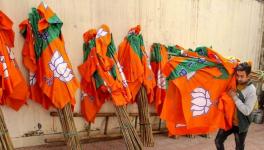Why JNU’s Opponents Need History Lessons From Kartarpur
Correct me if I am wrong, but the opening of the Kartarpur corridor has brought the Sikh and Muslim communities closer. The Partition and its aftermath had created friction and a wide chasm between the two communities, which lasted untill the efforts of few individuals who tried to bridge this gap. I recall the late author Khushwant Singh telling me that when the Rockefeller Foundation gave him a fellowship to write on the history of the Sikhs, he deliberately chose the Aligarh Muslim University or AMU. Why? To quote Khushwant, “I could have chosen Delhi University or the Jawaharlal Nehru University, but I chose AMU because I wanted to do my bit to bridge the distance between the Sikhs and the Muslims.”
After Khushwant wrote his two volumes on the history of the Sikhs, he added two Latin words, Opus Exegi, or my life’s work is done, to the finished book. To write about Sikhism and its history was his greatest ambition and having done that he felt like “one living on borrowed time, at peace with myself and the world.” He also told me that it would not bother him if he wrote nothing else after this.
Definite pointers to the Sikh-Muslim bond getting renewed afresh can be witnessed in the Kashmir Valley as well. Right from the early 1990s, I have witnessed to this connection, and it has always been heartening to watch how it unfold. For instance, the hapless and indigent find shelter, solace and some food in gurudwaras of the Kashmir region. Even in the interiors of the Valley, one can be sure of meeting Sikh families who call themselves Kashmiri Sikhs. They have fused with the Kashmiri Muslims and live in complete congeniality. Needless to say, the tough situation prevailing for decades in Kashmir has only made their affinity grow stronger. Now there is more congeniality than ever before between the Sikhs and the Muslims.
This was confirmed to me also by those I met in Kashmir, like the Srinagar-based lawyer Hardev Singh Oberio. “Though my home was partially destroyed during the 2014 floods in Srinagar, I did not even think of moving out of here,” he told me. “We Sikhs will always be here. No one from my family moved out even during the turbulent nineties.”
Oberoi told me that not just he but his entire clan has been at ease in the Valley. “I am closer to my Muslim friends than I am with my family. I feel that they can give their lives for. The only thing is that they are very sensitive about their faith,” he added.
Against this backdrop, today, with the opening of the Kartarpur corridor, the bonhommie between the Sikhs and Muslims in other parts of the country is heartening to watch. The emotional pitch of their getting to know each other afresh, to rekindle their age-old ties again, is so high these days that several of my Sikh friends hugged me and others greeted me with salaams and more salaams!
It is touching to experience this affinity between the two communities, who share a common history, which includes much turmoil and uprooting. Of course, they have also been victims of communal violence. I recall that after the horrifying 1984 anti-Sikh riots, many Sikhs friends told me that they could empathise with the Muslims and what they go through, each time they are targeted, or attacked during communal riots.
******
Why are we hell bent on destroying educational institutions, and with that the lives of our children, the students? Obviously, I am incensed by the mess being created in and around the prestigious Jawaharlal Nehru University (JNU) campus. Television has been showing our students being dragged, pulled, pushed, thrashed and beaten by the police. This was unsettling enough for any onlooker, and yet the vice chancellor of the university sits easy—far too settled.
For the last few years, the political rulers at the centre have tried to intrude into the very functioning of JNU, while they are simultaneously busy intruding into the everyday lives of its students. The problem is that this university has produced a number of literary, academic and cultural giants. Just a visit to the campus shows how engaging its academic space is. To a casual visitor, JNU came across as an extension of a dreamy academic getaway set in a isle of calm. Each time I had walked around the campus made me wonder why people ever moved out of it. JNU is a small structured township, with greenery, tall trees and excellent roads that keep its students and departments connected.
All said and done, there is something very different about this university that it has held out against all it has been subjected to by the government of the day. I read through JNU social sciences department teacher Rakesh Batabyal’s book, JNU: The Making of a University, to find answers to why it has not succumbed or given up in the face of tremendous pressure. Batabyal traces the evolution of JNU until about 1989, which is around when he had enrolled in it.
It is worthwhile to cite a short discussion that took place in the Rajya Sabha in 1965 on the bill moved to create this university, the JNU Bill. ‘A utopian university of unsurpassed excellence was beginning to take shape in the minds of the cabinet members until Bhupesh Gupta, the down-to-earth communist leader, joined the debate and introduced a new sense of realism and practicality to the discussions...,’ Batabyal says in his book.
Gupta then proposed to not set up a Cambridge or an Oxford in India, but a university ‘viewed from the perspective of the prevailing economic conditions in India’. Batabyal says, ‘The first thing,’ according to him [Gupta], was to ensure the doors of the universities are thrown wide open to the ‘sons of the working people, the workers, the peasants and the middle classes’. Batabyal records, ‘...the government of India would need take socio-economic profile and its own cultural needs into account, and plan for the new university appropriately. It was the poor sections of the community which needed education; a high-flying expensive institution would make no sense at all in a poor country.’
That was just the beginning. After this, a series of discussions, changes, amendments and revisions took place in the vision and streams of education that were to be taught at JNU (and Indian universities in general). The core of education at JNU would be the notion that institutions of learning should be inclusive, not just a place where the “overflow” of students are to be accommodated.
This book is a massive education on JNU’s past and how its academic credentials evolved through discussion and debate. Let us not commit the folly of allowing the ruling political party to destroy it on useless alibis. The students want a reversal in the hiked teaching and accommodation fees and flexibility in their timings restored. And why not? Should not the students be free to voice their demands, and get them fulfilled?
The author is a freelance journalist and political commentator. The views are personal.
Get the latest reports & analysis with people's perspective on Protests, movements & deep analytical videos, discussions of the current affairs in your Telegram app. Subscribe to NewsClick's Telegram channel & get Real-Time updates on stories, as they get published on our website.
























